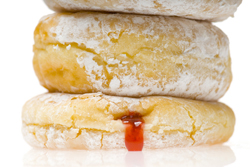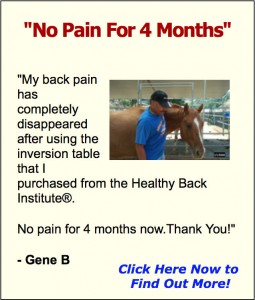“I think I slipped a disc,” is one of the most common phrases I hear from back pain patients.
The truth is, you can’t really slip a disc. Your intervertebral discs are fused to the vertebrae of your spine. They help keep each bone aligned and supported.
You can imagine intervertebral discs by thinking of a thick, spongy jelly doughnut. At the core is a bundle of protein and loose fibers called the nucleus pulposus – the “jelly” – and it’s surrounded by 16-20 layers of thick, fibrous bands called the annulus fibrosus.
When discs are healthy, they are thick, flexible and comfortable. But when they’re unhealthy, dehydrated and thin–look out. Chronic back pain from degenerative disc disease is in your near future.
Thankfully, disc degeneration and chronic back pain can be prevented. You can directly influence how healthy your intervertebral discs are!
Here are seven of my top tips for keeping a full set of thick, healthy spinal discs.
The 7 Most Essential Tips
for Spinal Disc Health
1. Stay Hydrated
Intervertebral discs love water – they’re comprised of 77% water! Without water, they lose their spongy nature and increase your risk for disc degeneration. Sipping water throughout the day – as well as reducing dehydrating beverages like soda, tea, or coffee – will greatly increase your spinal disc health.
2. Exercise Regularly
Studies show that consistent exercise – in one case, for 50 minutes, 5 days per week – helps naturally regenerate cells in intervertebral discs. The reason is simple: your spinal discs don’t have a good blood supply. Simply using your discs through motion serves as a pump to keep fluids with important nutrients moving through them. Since discs naturally degenerate over time, action you take to keep them functional rather than stagnating and shrinking is helpful.
3. Practice Good Posture
Your discs are designed to flex with your movement, but extended periods of poor posture can cause them to dehydrate unevenly. According to a 1983 study, after four hours of flexed posture, the fluid of the annulus (the outer fibers) are dehydrated by 15%, but in erect (correct) posture, it only loses 10% of its fluid. They concluded that simply sitting properly not only prevents excess fluid loss, but improves nutrient flow to the disc.
And of course, remember to always lift heavy items with your knees and legs, not your back to prevent hernias or bulges from excess unbalanced pressure.
4. Keep Muscles Balanced
Usually, muscle imbalances are caused by one group of muscles becoming too tight, while opposing muscles become stretched and weakened. That group of too-tight muscles often pulls the spine out of alignment as well, leading to the extended periods of poor posture you just discovered. You can identify and correct muscle imbalances through simple but targeted stretches and exercises using the Lose the Back Pain System.
5. Lose Weight and Stop Smoking
These two oft repeated mantras for good health also apply to your discs. Weight loss will help reduce the overall load on your spinal discs. And scientists have also found that “cigarette smokers have an increased risk of low back pain which may be caused by disc degeneration and spinal instability.”
6. Sleep Well
Your discs are under the least pressure when you lay flat on your back. Sleeping as many hours as you can on your back gives your discs maximum time to unload and rehydrate. Try using a small rolled towel or folded sheet to provide extra support for the curve in your lower back for maximum comfort.
7. Practice Spinal Decompression
Even though your discs get the most relief from laying flat on your back during sleep, they are still under pressure from gravity and supporting your spine. Spinal decompression is a simple yet highly effective therapy that allows your vertebrae to release your spinal discs from pressure so they can fully rehydrate and relax.
There are a few options for spinal decompression:
- Surgical spinal decompression. The most expensive, painful and uncertain option, surgery may not result in long-term pain relief. In fact, between 10% and 40% of patients who go under the knife come out with “Failed Back Surgery Syndrome,” where pain persists despite surgery.
- Clinical spinal decompression. You may be able to use a DRX 9000 or Vax-D machine if your chiropractor or local clinic has one. Total treatment time is typically 30 minutes… not to mention the drive and waiting room time… or the expense, which can add up to over $4000 in less than a 6 month period for a typical course of treatment.
- Inversion therapy (top-recommended). Inversion for back pain has been around for over 2,000 years, and it has been scientifically proven so effective that even the U.S. Army uses it for soldiers…
Click Here Now to See How YOU Can Use Inversion Therapy to STOP Your Pain and Improve Your Spinal Disc Health!
References
(1) Fogelholm RR. Smoking and intervertebral disc degeneration. Medical Hypotheses. 2001 Apr;56(4):537-9.
(2) Adams MA. The effect of posture on the fluid content of lumbar intervertebral discs. Spine (Phila Pa 1976). 1983 Sep;8(6):665-71.
(3) Sasaki N. Physical exercise affects cell proliferation in lumbar intervertebral disc regions in rats. Spine (Phila Pa 1976). 2012 Aug 1;37(17):1440-7.




Hi,
My name is Robert Gibson, from the UK.
Over several years I have suffered with sciatic, I have had various amount of treatment including lumber root block and prescription tablets.
I have narrowing of the spine, and a bulging disc. I exercise frequently for several years, but struggling with pain around the lumbar region and both legs. Could you please give me some sound advice on relief ?
Thank you,
Robert Gibson
Hi Robert,
Please do get yourself a copy of our back pain book The 7 Day Back Pain Cure. It has a lot of information regarding the back, treatment options and pain relief plus many other useful aspects for you to read and consider. We do hope you find it helpful.
https://losethebackpain.com/products/7-day-back-pain-cure-book
Thank you
Admin (THBI)